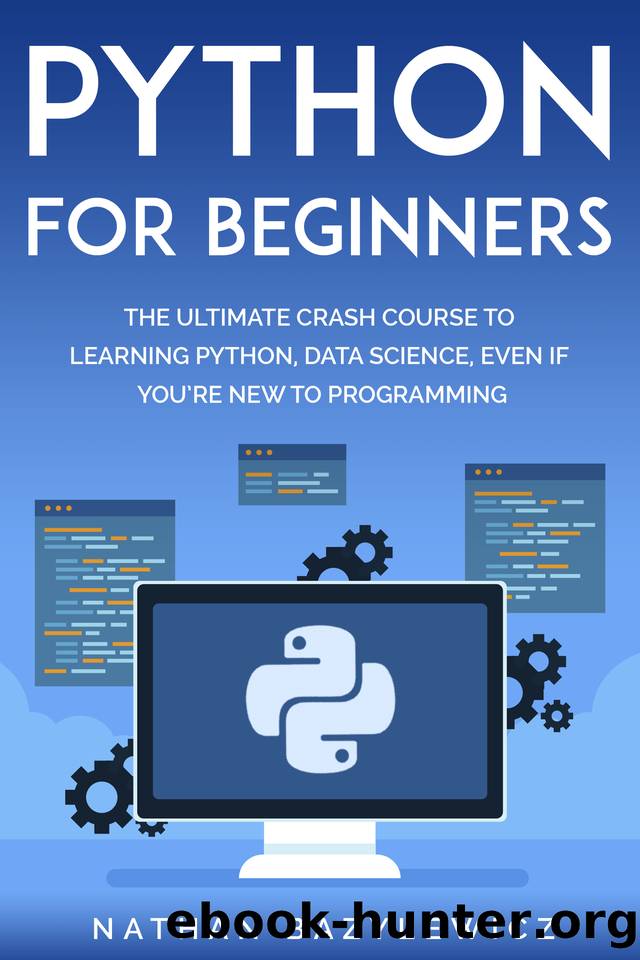Python for Beginners: The Ultimate Crash Course to Learning Python, Data Science, Even If You’re New to Programming. by Nathan Bazylewicz

Author:Nathan Bazylewicz [Bazylewicz, Nathan]
Language: eng
Format: azw3
Published: 2020-05-25T16:00:00+00:00
The thing that you will want to remember when you are working with these variables is that you have to assign a value in order to make the work happen in the code. These variables are also just going to be spots in your code that are going to reserve some memory for the values of your choice.
The Python Strings
The next topic that we need to take a look at in this chapter is going to be all about the strings. These strings are going to help us to learn more about how we can control some of the different parts of our codes, and will make it easier to understand what the string is. as a review, a string is just going to include a series of text characters that are found in our code for us to use.
Now, when you are working with these strings, you will find that there are some different types of operators that you are able to use when you bring them up. An operator is simply a symbol that is able to perform a specific operation that is inside of your code. When we are in this kind of situation, the operation is going to be performed on the strings. Some of the operators that you are going to be able to find here will include some of the following:
1. The concatenation operator: This is going to be the type of operator that you will use when it is time to take those strings and concatenate them.
2. Repetition operator: This is going to be the type of operator that you are able to use when you would like to get more than one copy of your string, and often many of these copies. You are able to use this one and then choose the number of times you would like to see the string repeat.
3. Slice operator: This is going to be an operator that will take a look through the chosen string, and then will figure out the specific character that you would like to work with from there. Any time that we bring this one up, you will need to remember that the first character of your string is going to be zero.
4. Range slice operator: This is another operator that we are able to use because it can retrieve a range of characters out of the index, rather than just one character to you. If you would just like to have it showcase out one part, or one word, of that string, then you would need to work with this operator.
5. In operator: This operator is going to spend some time searching for a specified character in your target string. If you do have that specific character found in the string, then you will get the True answer returned to you. But if the operator is not able to find that answer in the string, then the False answer is going to be returned to you.
6. No in operator: This is the operator that will work in the opposite manner as the in operator.
Download
This site does not store any files on its server. We only index and link to content provided by other sites. Please contact the content providers to delete copyright contents if any and email us, we'll remove relevant links or contents immediately.
| Access | Data Mining |
| Data Modeling & Design | Data Processing |
| Data Warehousing | MySQL |
| Oracle | Other Databases |
| Relational Databases | SQL |
Algorithms of the Intelligent Web by Haralambos Marmanis;Dmitry Babenko(9832)
Azure Data and AI Architect Handbook by Olivier Mertens & Breght Van Baelen(7607)
Building Statistical Models in Python by Huy Hoang Nguyen & Paul N Adams & Stuart J Miller(7591)
Serverless Machine Learning with Amazon Redshift ML by Debu Panda & Phil Bates & Bhanu Pittampally & Sumeet Joshi(7476)
Data Wrangling on AWS by Navnit Shukla | Sankar M | Sam Palani(7234)
Driving Data Quality with Data Contracts by Andrew Jones(7230)
Machine Learning Model Serving Patterns and Best Practices by Md Johirul Islam(6962)
Learning SQL by Alan Beaulieu(6209)
Weapons of Math Destruction by Cathy O'Neil(6143)
Big Data Analysis with Python by Ivan Marin(5883)
Data Engineering with dbt by Roberto Zagni(4897)
Solidity Programming Essentials by Ritesh Modi(4528)
Time Series Analysis with Python Cookbook by Tarek A. Atwan(4358)
Pandas Cookbook by Theodore Petrou(4057)
Blockchain Basics by Daniel Drescher(3507)
Natural Language Processing with Java Cookbook by Richard M. Reese(3099)
Hands-On Machine Learning for Algorithmic Trading by Stefan Jansen(3027)
Feature Store for Machine Learning by Jayanth Kumar M J(2908)
Learn T-SQL Querying by Pam Lahoud & Pedro Lopes(2878)
